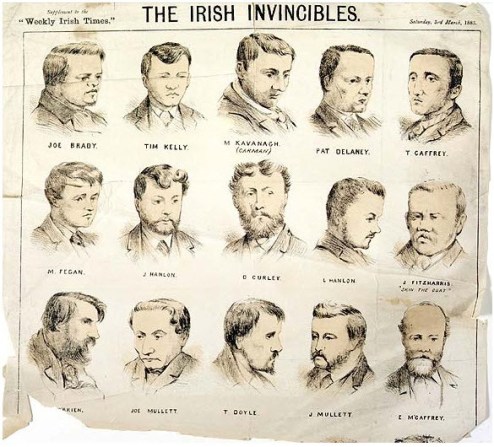Diarmuid Breatnach
Today is the anniversary of the death of Pat O’Donnel, an Irish patriot or a murderer, depending on one’s point of view. There are memorials to him both in his native village and in Glasnevin Cemetery in Dublin, the latter paid for by US-Irish contributions.
Pat O’Donnel was a travelled man with an interesting life story (the little of it that is known). He was born in Gaoth Dobhair (which remains an Irish-speaking area today in Co. Donegal) in 1835 and emigrated to the USA where, among other things, he worked as a miner. He stayed with his cousins for a while, who were with the ‘Molly Maguires’ (a workers’ underground resistance organization), in the coal-mining area of the state of Pennsylvania.
His greatest claim to fame however is that he killed James Carey, a man who informed on his “National Invincibles” comrades who in 1882 had assassinated Lord Cavendish, newly-appointed Chief Secretary of Ireland and Thomas Henry Burke, Permanent Under-Secretary – i.e. both chief representatives of British colonialism in Ireland — as they walked through Phoenix Park.

The British made arrangements for Carey which bear most of the features of the “witness protection program” of the FBI as presented in a number of fictional Hollywood films. Carey was given money in payment for his treachery, a new identity and passage for him and his family to begin a new life in South Africa.
There is no dispute that O’Donnell shot Carey a number of times and killed him in the latter’s cabin on board ship. The rest has been the subject of discussion and even argument but it does seem likely that although O’Donnell did intend to kill Carey, he provoked him and gave him a chance to go for his gun. Carey’s son probably concealed the weapon when O’Donnell was arrested in Carey’s quarters. Had Carey’s gun been produced in the cabin, instead of being found later on the son, it would have given O’Donnell some chance of being convicted of manslaughter instead of murder.
The biggest debate is about whether O’Donnell was sent to kill Carey or whether, after befriending him and his family, he learned of his identity and decided then to kill him. Evidence points in both directions although O’Donnell’s behaviour in the Carey family’s company tends towards the second interpretation, which is what most historians hold to. Most non-historians seem to prefer the story that O’Donnell was sent as an instrument of justice against informers and there is a Dublin folklore tradition to that effect. Curiously, the jury too preferred that theory — or that O’Donnell had shot an unarmed man — and found him guilty of “willful murder”.
Even most of those in Ireland who were horrified at the assassinations of the British colonial representatives despised Carey, who had been the one to actually give the signal for the fatal assaults and later seemed to delight in condemning six of his former colleagues to death — and others to prison sentences — by his evidence at their trials.

(Portrait by unknown engraver)
My great-grandfather J. J. Walsh was one of the legal team defending the Invincibles but my feelings about Carey would have been the same even had I not known that. It is recorded that eight great bonfires were lit in Ireland in celebration at the news of Carey’s death and that musicians led thousands in joyful processions.
The Judge refused to allow O’Donnell to speak after passing sentence upon him but the convicted man shouted “Three cheers for Ireland! Goodbye, United States! To hell with the British and the British Crown!“
The President of the USA intervened to try to save his life, since he had become a US citizen, but Pat O’Donnell was hung this day in Newgate prison, one hundred and thirty-one years ago and is numbered among the hundreds of thousands of men and women who fell in the fight for Irish Freedom.
(* “Skin the Goat” was the nickname of the assassination group’s getaway cart driver, whose real name was John Fitzharris; he served a long sentence for refusing to give information on anyone).
Further information and songs:
Pat O’Donnell, the Invincibles and Carey also get a mention in one verse of “Take Me up to Monto” by Irish Times journalist George Hodnett (a colleague of my father’s):
“When Carey told on ‘Skin the Goat’*,
O’Donnell caught him on the boat —
He wished he’d never been afloat,
The dirty skite!
It wasn’t very sensible
To tell on the Invincibles —
They stood up for their principles
Day and night.
And they all went up to Monto, Monto, Monto …” etc
There’s a good article here by historian Shane McKenna in which he calls the event in Phoenix Park “killings”, unlike their usual description as “murders” even in articles from Irish writers — evidence that the hand of colonialism still rests on our brains. Elsewhere one reads in history about the “assassination” of Arch-Duke Ferdinand, of Lincoln etc. They are not usually described as “murders”.
http://www.theirishstory.com/…/the-invincibles-and…/…
A version of the Pat O’Donnell Ballad sung by Diarmuid Breatnach (at 19.40 minutes on the video), 23rd February 2013 as part of the Songs from the Docks event, preceded by Paul O’Brien, Seán O’Casey Centre, East Wall; video Rashers O’Reilly)
Lyrics: Traditional
Air: Traditional.
Video: https://www.youtube.com/watch?v=FAjGR6ThjcE
Another version of the Pat O’Donnell ballad, sung by Martin Collins, a Traveller who got it from his father Johnny Collins, sung here at the Celebration of Irish Traveller Music event at the Cobblestone pub, Smithfield, Dublin on 11th December 2014:
https://www.youtube.com/watch?v=7Ntgh9AcFSw&list=UUNHsW6A2NOiCjPjIkE5Sc0w#t=28
There exists also a song about one of the Invincibles, Joe Brady, a Fenian Blade.


Pingback: JANUARY — BIRTHS AND STATE EXECUTIONS | rebelbreeze